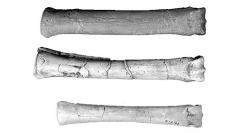

 Geodiversitas
25 (2) - Pages 297-319
Geodiversitas
25 (2) - Pages 297-319Sahabi is a latest Miocene/earliest Pliocene vertebrate fauna from Libya. It includes a mixture of Eurasian and African vertebrates, and as such is important for biogeographic reconstruction and paleoecologic comparisons. We undertake a morphometric analysis of Sahabi hipparion metacarpal 3s, metatarsal 3s and 1st phalanges 3 in order to reevaluate and revise this assemblages' systematics, biogeographic relationships and paleoecologic setting. In so doing we recognize two hipparion taxa at Sahabi: a slender-limbed form adapted for open country cursoriality, "Cremohipparion" aff. matthewi; and a robust-limbed form, a likely woodland denizen with likely less cursorial capability, "Hipparion" sp. (Sivalhippus Complex). "Cremohipparion" aff. matthewi exhibits its closest affinity with the Samos and Maramena slender-limbed hipparions of the Cremohipparion matthewi/nikosi lineage. We believe that this lineage also likely includes the Indo-Pakistan hipparion, "Cremohipparion" antelopinum. This lineage provides evidence for a late Miocene hipparion biogeographic connection between Indo-Pakistan, Southwest Asia, the Eastern Mediterranean and North Africa. The large Sahabi form "Hipparion" sp. (Sivalhippus Complex) would appear to belong to a lineage whose late Miocene distribution was between Indo-Pakistan, North Africa and East Africa. The East African slender-limbed form Eurygnathohippus feibeli would appear to be convergent on the "Cremohipparion" small slender-limbed hipparion, having synapomorphies of the lower dentition with the Eurygnathohippus radicle of the "Sivalhippus" Complex.
Mammalia, Equidae, hipparion, Sahabi, Libya, postcrania, biogeography, paleoecology